Types Of Persian Rugs
How many different types of persian rugs are there?
There are many persian rug styles, and in a moment we’ll take a look at all the different types of persian carpets available.
To begin, let’s look at the 3 main oriental rug styles… to do this, we’ll have to go back in time…
All the way back to 3000 BC – 1200 BC.
Because this is when the incredible art of rug weaving started.
Documents show that persian carpets go all the way back to the ancient Greeks. As it was Homer (who wrote the poem ‘Iliad’ in 850BC) that spoke of magical lands and “splendid carpets”.
Which in historical terms, was around the Bronze Age.
And because of this long and rich history, the types of middle eastern rugs evolved tremendously over the years.
From humble beginnings, (where rugs were weaved out of necessity – to keep mountain people and travelling tribes warm and out of the wind)…
… to the royalty of Persia demanding that they too must-see these majestic and “Splendid Carpets” adorn their own floors and walls…
… all the way to the palatial homes of Kings & Queens in Europe and further still… into the whitehouse in America.
It’s safe to say these “Magic Carpets” have travelled a long way.
Table of Contents
Types Of Oriental Rugs
What are the different types of persian rugs?
What you’re about to learn will make identifying types of oriental rugs much easier.
Also you can learn about what is the difference between Persian Rugs vs Oriental Rugs.
Persian Carpet Types
Persian rug types can be categorized into three distinct categories:
This makes the kinds of persian rugs you see today so unique. On one hand they are all from Ancient Persia (modern day Iran), which makes the majority of them highly desirable..
… but the fact that there were 3 distinct “types” of manufacture … 3 simultaneous lines of tradition — means that there is a color, pattern, style and type for almost everyone.
So how do you go about identifying types of persian rugs?
While an expert would easily be able to differentiate a Tabriz from a Heriz rug, and a Kashan from an Isfahan, can you?
By the time you’re done reading this article you’ll be well on your way.
Here are a few distinctive characteristics of each type that will help you impress anyone with your knowledge of Persian rugs:
Types of Persian Rugs
Tabriz Rugs
Tabriz rugs originate from Tabriz, capital city of Azerbaijan and one of the oldest rug weaving centers in the region. These are high quality rugs with a wool or wool/silk pile and a cotton or silk warp.
The patterns range from teardrop medallions to floral, trees and hunting scenes. Antique Tabriz rugs are extremely valuable and can only be found in exclusive private collections and museums.
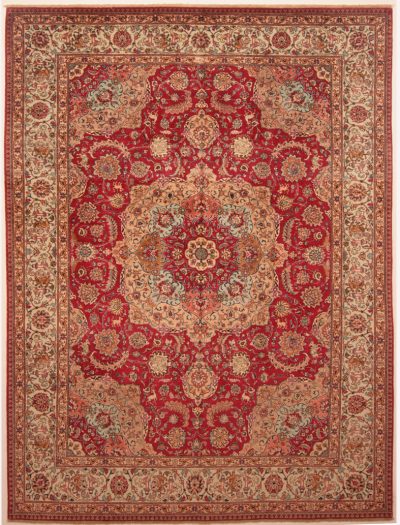
Some of our Tabriz Rugs
Heriz Rugs
Bright vibrant colors and characteristic bold patterns make these rugs easy to identify. Heriz rugs will always feature an oversized medallion in the center, with a double or triple outline and large corner pieces. These rugs are very durable and will last for generations.
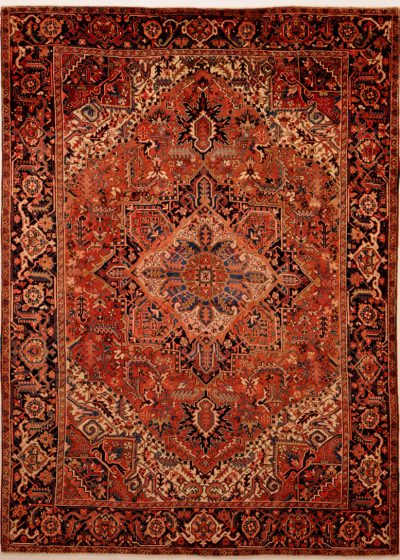
Kashan Rugs
The medallion and corner pattern on an ornately patterned floral field is a trademark of Kashan rugs. The colors used in the designing is usually a combination of deep blues, rich reds and ivory with occasional splotches of yellow, green and burnt orange. These rugs are high quality with a knot count that ranges from 100kpsi to over 800 kpsi.
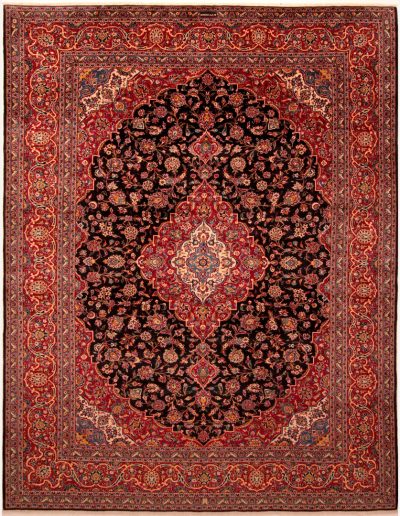
Video Covering 7 Types of Traditional Persian Rugs
Persian Rug Identification
So how does one know what to look for when identifying oriental rug patterns?
First, let’s clarify machine-made from hand-knotted.
Take a look at this:
In the image on the left, we see a plastic layer on the back of this rug, (which indicates it is machine-made) whereas in the image on the right, we see the same coloration/texture on both sides indicating a hand-knotted Persian rug.
On closer inspection we see more differences in this photo here:
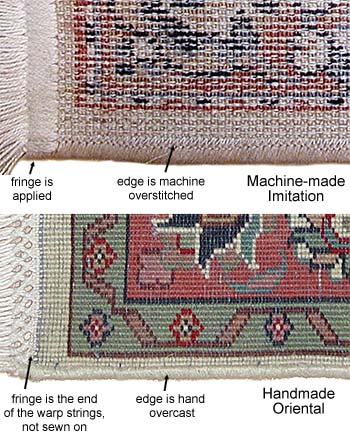
And just to make it even easier to tell original persian carpet designs from unoriginals, we see the following:
But how do you identify types of Persian rugs with more certainty?
If we’re talking authentic, genuine, hand-knotted Perisan Rugs…
… then beware of hard plastic backing, bleeding colors, make sure the fringe is NOT sewn or glued on and ensure you always purchase from a reputable dealer that displays their prices upfront.
However, if we’re talking about the origin of a rug, what specific type it is, how old it is etc — it can be a bit more difficult. But here are 2 of the easiest things you can do:
Continue reading this article to familiarize yourself with the different rug types. Check out our rug category pages here and our rug encyclopedia here.
Speak to the experts. A Persian rug expert can help you better understand the types of handmade rugs, appraise a rug you own, and offer you insights gained from a lifetime in the rug business. Which can save you time (and potentially money). This is specially important if you are a new to buying Persian rugs and need to get as much information as possible before investing.
Gabbeh Rugs
Woven by Qashqai and Luri weavers in the Zagros Mountains, the tribal influence is very evident in Gabbeh rugs. Made of local handspun wool, these rugs are thick and coarse and the designs are simple and woven on a plain lush field of color. Only natural dyes are used and typical colors of these rugs are orange, yellow, rust or red.
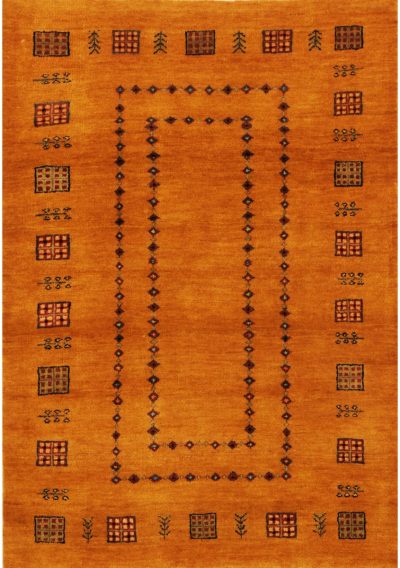
Isfahan Rugs
The design of silk and wool design Isfahan rugs is very balanced and symmetrical. Typically it will consist of a single indigo, rose or blue medallion surrounded by vines and woven on an ivory background.
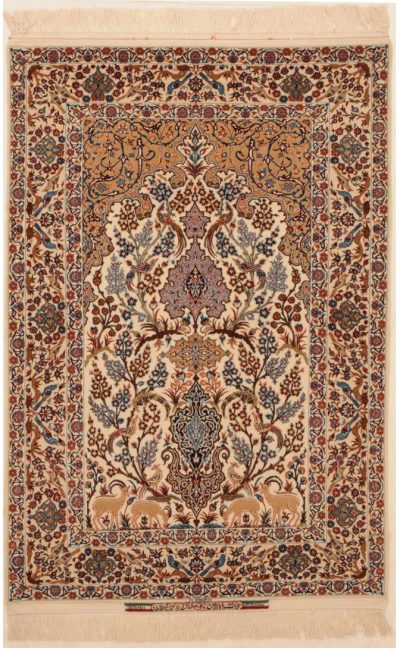
Some of our Silk & Wool Rugs
Nain Rugs
Nain rugs are high quality with very fine quality wool and a knot count of about 300 kpsi to 700 kpsi. The patterns are very intricate and usually consist of blue or green intertwined branches with tiny flowers woven on a white or light ivory background.
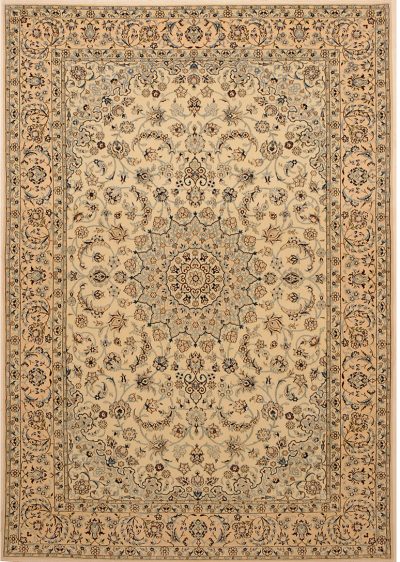
Some of our Nain Rugs
Persian Carpet Designs
The most common Persian patterns and motifs are:
- Floral
- Allover
- Geometrical
- Medallion
- Herati
- Boteh
- Tribal
- Open Field
- Birds & flowers
- Hunting
- Garden design
- Pictorial
- Tree of Life
So how many rug pattern names did you spot?
The reason there are so many oriental rug patterns is largely due to the fact that carpet-weaving started 2,500 years ago and as such — the oriental and persian rug patterns history is weaved as a story into the very fabric of each rug.
Persian Rug Patterns
So what types of persian rug patterns do you favor?
The good news is, last time we did an inventory check, we had at least one Persian or Oriental Rug with each rug pattern in stock — so you’re sure to find something you like.
Please remember: Each hand-knotted persian rug is a one-off piece of unique artwork. So if something catches your eye, be sure to get it before someone else does. Shop Now!
Sarouk Rugs
Sarouk Carpets are of a fine compact weave, with mellow colors, often featuring medallion designs. Compatible with traditional or contemporary decor, a Sarouk Rug complements a wide array of rooms, (both large and small), are known for striking color, durability and charm.
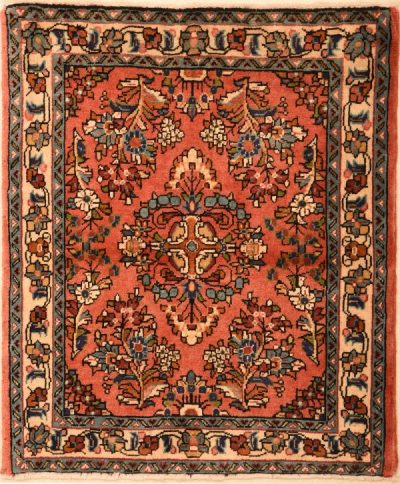
Mashad Rugs
Mashad rugs (also spelled: Mashhad or Meshad) typically feature a lone, oversized Shah Abbasi medallion in the center on an elaborate background filled with floral motifs in a curvilinear design. These rugs are usually large with a wool pile and a cotton foundation.
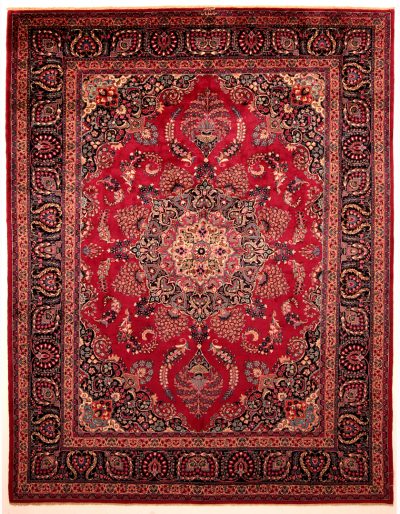
Kerman Rugs
Kerman rugs are one of the finest types of Persian rugs. They are best known for their wide range of designs and color combinations. Kerman rugs have very distinct type of dyes that are created by their master weavers.
Kerman rugs come from the city of Kerman, which is located in South Central Iran. This area has been settled since the 4th Centry and a very important location for trading between Iran and India. The rug weaving industry started in Kerman since the 19th century.
Kerman rugs are made with Cotton foundation and wool pile. And some Kerman rugs have Silk and Wool Pile. Kerman rugs have Kork wool which is made from Sheep in the region. Kerman rugs comes in a variety of designs such as floral, allover, tree of life design, garden design, and open field design.
Balouchi Rugs
Because of Baluchi rug’s nomadic tribal original, you’ll rarely find a large sized Balouch rug. These small rugs have simple geometric patterns and are woven with sheep wool that is dyed blue or dark red. The edges use camel or goat hair in beige or brown.
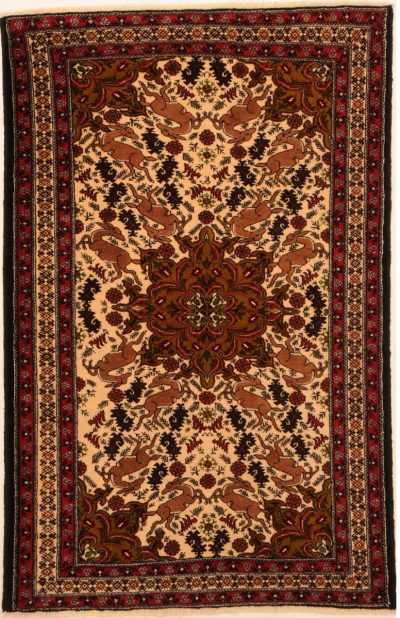
Qum Rugs
Also known as Koum, Kom, Kumm, Qhum, or Ghom, these rugs are woven in the Qum province of Iran. Qum rugs are very high quality. They are tightly knotted, with a luxurious pile of silk or cotton and intricate designs that include a combination of flowers, birds, medallions, hunting scenes and gardens in dark blue, reddish brown or orange. Turquoise is always used in some element in a Qum rug.
Hamadan Rugs
The Hamadan rug is one of the oldest Persian Carpet types to date. The term “Hamadan rug” doesn’t just refer to their birthplace. It’s a collective name for all rugs woven in that region, which is home to more than a thousand different villages, all producing unique and separate Hamadan rug varieties.
These village rugs are treasured pieces, most of which eventually turn into heirlooms passed down through generations.
Part of these rugs’ impressive durability is the material itself. Hamadan is in the foothills of the Alvand Mountain, which sits at 1850 meters above sea level. Because of the cool mountainous climate, the area’s sheep produce hardy and resilient wool, which is then used to weave the cotton foundation of Hamadan rugs.
The weaving technique also contributes to the rugs’ strength. Most Hamadan rug weavers use single wefting techniques and Turkish knotting techniques to create coarsely woven pieces with low knot counts. This weaving signature is a great way to identify Hamadan rugs.
Finally, antique Hamadan rugs traditionally feature central medallions surrounded by smaller motifs and patterns. These secondary motifs usually include arabesques, diamonds, palmettes, and other geometrical shapes. The general color palette contains varying hues of red, navy, and ivory with black and other pops of color, depending on which tribe the rugs were originally woven by.
A Hamadan rug is a timeless testament to the creative spirit, strength, and durability of the craftspeople who weave them.
Zanjan Rugs
Zanjan rugs are another favorite of rug collectors around the world. These Persian pieces, named after their ancient city of origin, are prized for their vibrant color palettes and unique tribal designs.
Most Zanjan rugs are single wefted in the center with wool or cotton foundations. They also feature both symmetrical Turkish knots and asymmetrical Persian knots.
Zanjan rug designs vary from tribe to tribe, but many feature central medallions with a smaller medallion in the center. The medallions and background are adorned with geometric designs of star motifs, flower heads, birds, animals, and fish or paisley patterns.
For the color palette, Zanjan weavers used the region’s typical reds and dark blues plus lighter hues like ivory. They would often alternate these base tones for the background, medallions, and border. To add more detail and complexity to the design, they highlighted other design elements and minor borders with various shades of gray, green, brown, camel, and blue.
The Zanjan weaving style is greatly influenced by Bija, its neighbor, which introduced Herati designs to Zanjan rugs. Hamadan influence on the weavers can also be seen in the small and simple patterns present in many Zanjan rugs. As a result, Zanjan rugs are generally more affordable compared to other types of Persian rugs.
Owning a Zanjan rug is an honor: these rare pieces are often gifted as special presents to royalty and dignitaries as a sign of trust and respect.
Malayer Rugs
Malayer rugs are some of the most sought-after Persian rugs today. Hailing from Malayer, which is in western Iran, the semi-nomadic weavers of Malayer rugs are fiercely faithful to their ancient techniques and shun modern methods.
Featuring a cotton foundation with a low-cut wool pile, Malayer rugs are single wefted and tightly woven using the symmetric Turkish knot.
As for the colors, the palette of the Malayer rug is both rustic and sophisticated. Similar to many Persian rugs, reds, ivory, and navy blues are common, but Malayer rugs are also known for their beautifully contrasting ivory and navy borders.
The subject matter of Malayer rugs is decidedly traditional. Motifs like the Tree of Life, Herati (fish), and medallion motifs with paisley designs are quite popular. They also incorporate symbols like palmettes, flowers, and vines. Because the region is fondly called “the land of grapes”, grapevines, grapes, and tendrils are a common image, too.
Elegant, steeped in history, and unique, Malayer rugs are beautiful works of art.
Kilim Rugs
The beloved Kilim rugs are traditional, flat-woven rugs with no pile. Instead of knotting the wool pile like other rugs, Kilims are made by interweaving different colored weft and warp threads. This makes them more lightweight than other ancient Persian rugs.
You can also identify Kilims based on their slitweave. Look closely into the pattern and you’ll notice vertical slits running along the edges which beautifully highlight the striking geometric designs.
Each rug is a tapestry of vivid colors and bold motifs ranging from animals to geometrical shapes, plants, and primitive representations of natural events.
But most importantly, Kilims overflow with the emotions and stories of the weavers that made them. The symbols tell tales of good luck, peace, love, fertility and happiness, and protection from danger.
More than a magnificent piece of decoration, Kilims are a window into the lives of people and civilizations that shaped history.
Oushak Rugs
Oushak rugs, which are named after their birthplace in the city of Oushak in Western Anatolia, Turkey, are a traditional type of Turkish rug.
The Western Anatolia region has been a significant producer of rugs since the early Ottoman Empire period until the early 20th century, and Oushak rugs are still produced there today, also known as Usak rugs.
While Pakistan has now become a leading producer of these beautiful hand-knotted rugs, Oushak rugs remain strongly associated with their Turkish heritage.
Bokhara Rugs
Bokhara rugs are hand-knotted rugs made from handspun wool with vegetable dye. Bokhara rugs orginate in the Bukhara region of Uzbekistan.
These rugs are known for their repeating rows of guls, geometrical patterns, and extremely soft pile. Initially created by the nomadic Tekke tribe, Bokhara rugs’ designs were influenced by various tribes in Central Asia, including the Salor tribe. Today, these rugs are made in workshops in Pakistan.
Bokhara rugs are made from 100% wool pile and have a cotton foundation. The pile of Bokhara rugs is often a blend of New Zealand and Pakistani wool, creating a softer feel. The dyes used are a mix of natural vegetable dyes and synthetic dyes, typically in bold hues of red, green, blue, ivory, gold, and rose.
To distinguish a Bokhara rug from other similar rugs like Jaldar rugs, one can examine the design of the guls, coloring, pile, and feel of the rug. Bokhara rugs have more rounded guls, medium thickness, and a soft pile, reflecting the high-quality natural fibers used in their construction.
Types of Persian Carpets & Rugs
Traditional Persian Rugs
Bijar, Hamadan, Isfahan, Kashan, Kashmar, Kerman, Mahal, Malayer, Mashad, Mehraban, Moud Mashad, Nain, Qum, Sarab, Sarouk, Sultanabad, Tabriz, Zanjan.
Village Persian Rugs
Abadeh, Azerbaijan, Heriz, Jozan, Karaja, Qashqai, Senna.
Nomadic Persian Rugs / Tribal Persian Rugs
Bakhtiari rug, Balouchi, Persian Gabbeh, Quchan Kurdi, Shiraz, Turkoman.
Antique and Modern Oriental Rugs (Persian Style Rugs)
Afghan, Pakistan Bokhara, Pakistan Gabbeh, Kazak, Kilim, Peshawar, including Indian oriental rugs and asian rugs: Indo Gabbeh, Indo Mir, Indo Nepal, Indo Tibetan.
Video Transcription: Most of our rugs are Persian Rugs from Iran. We also carry Pakistan rugs (Oriental Rugs), because many of our customers like muted colors. Peshawar Rugs are particularly popular because they blend with almost any color furniture.
Types of Antique Persian Rugs – Iranian rugs are more colorful and they have many patterns, from geometric, hunting, floral, also medallion, Herati design. They have many, many different patterns, colors but they are very traditional colors, not subdued colors like a Pakistani Rug.
Persian Rug Designs – That’s why we think it’s important to either book an appointment to come and see the rugs in person (at our warehouse) or to schedule a video tour. So you get to see all the different types of persian rug designs available to you.
Types Of Rug Patterns – We have Kazak Rugs, these are more geometric style patterns and very popular with the younger crowd.We have many persian rug sizes, many persian carpet patterns, many colors, and it is kind of art. Each one is unique, different from each other, so it’s really based on your individual taste – and we generally find there is something for everyone.
Types Of Rugs Colors – In colder climates or just in general over winter, we all want to stay warm. One of the ways we can do this is obviously with central heating, or an open-fireplace. Another way in which we can make a room look and feel warmer is with the furniture and decoration. With rich colors and earthy types of oriental rugs on the floor and under your feet — you’ll instantly lift the mood of any room and add textures that evoke a sense of comfort and warmth.
Iranian City Famous For Carpets – Everyone knows the Swiss are famous for their watches and Persian Rugs are known worldwide as synonymous with luxury, style and sophistication. If you’d like to see a sample of the best of the best, go here to the Tabriz Rugs category page.
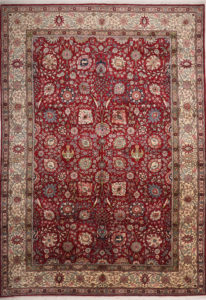
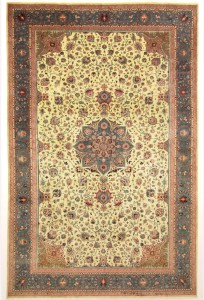
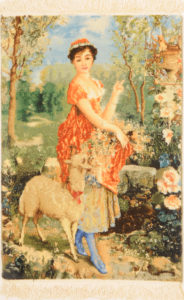
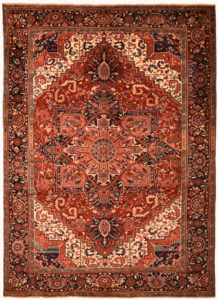
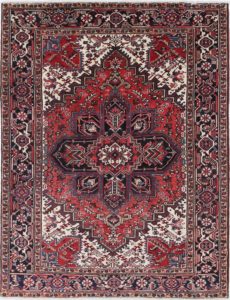
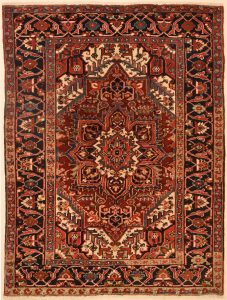
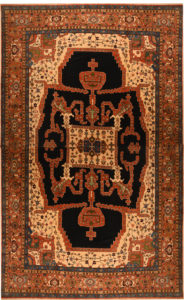
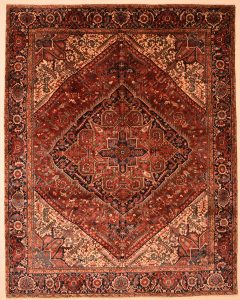
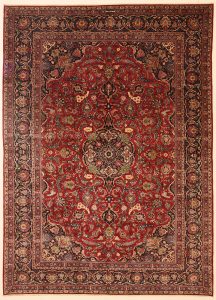
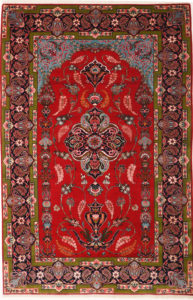
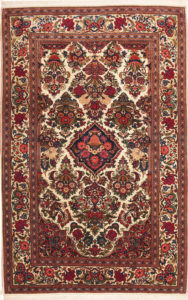
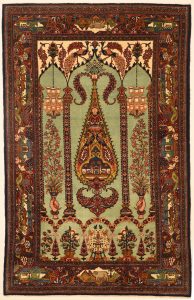
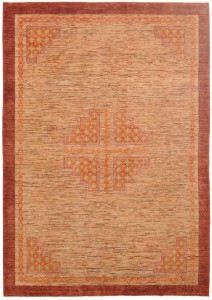
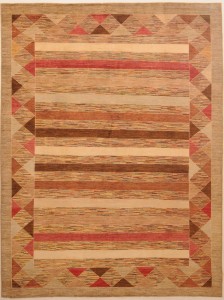
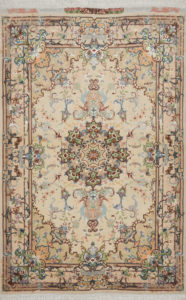
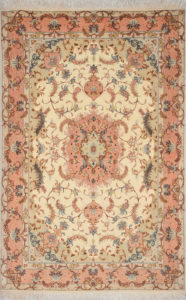
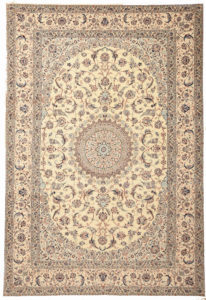
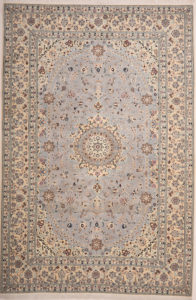
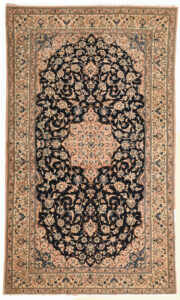
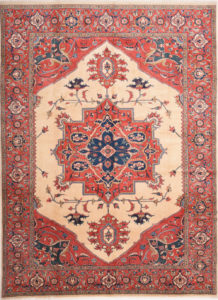
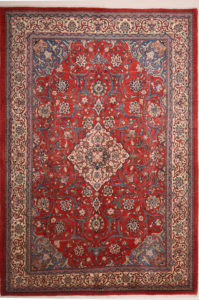
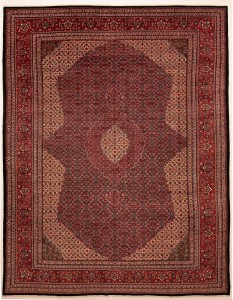
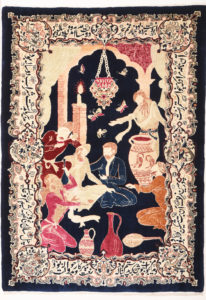
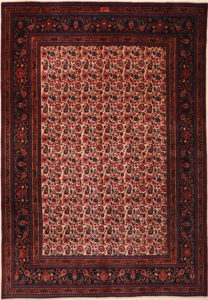
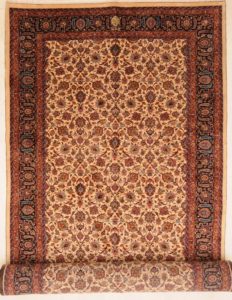
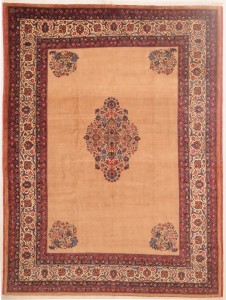
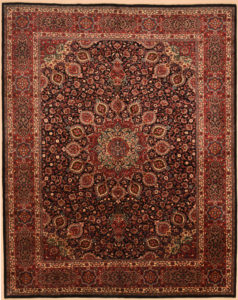
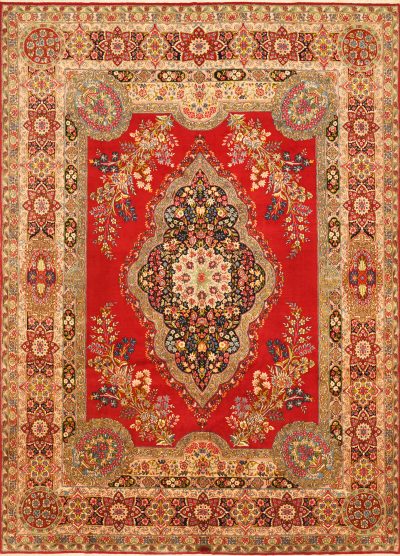
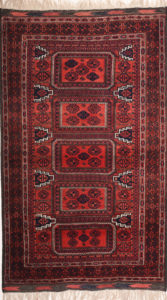
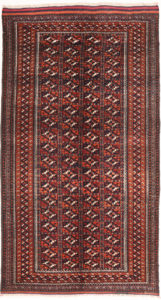
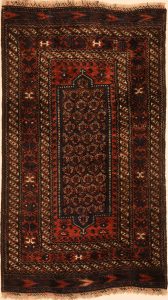
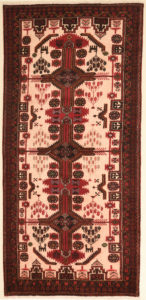
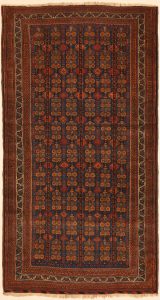
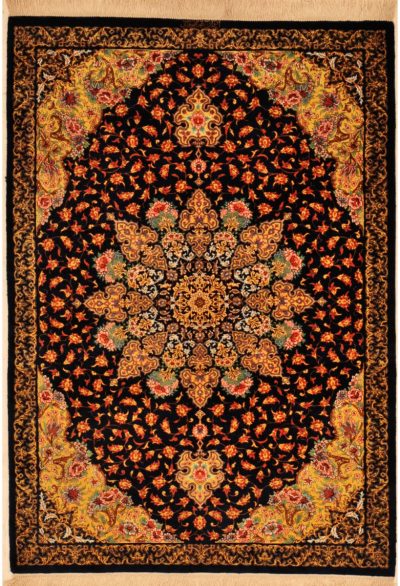
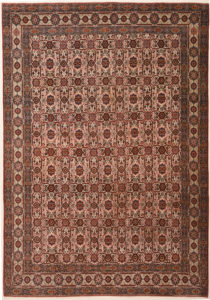

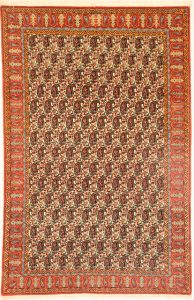
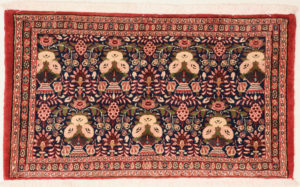
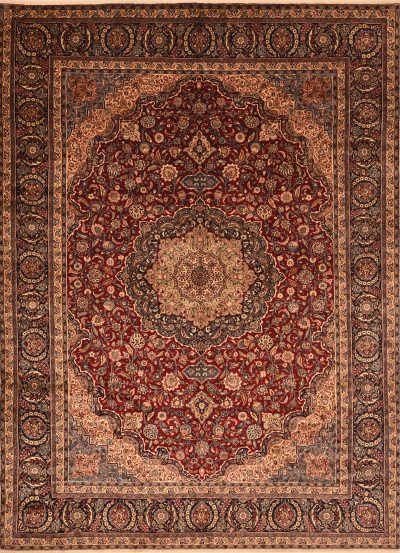
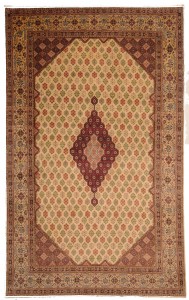
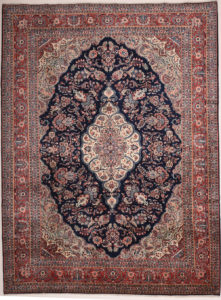
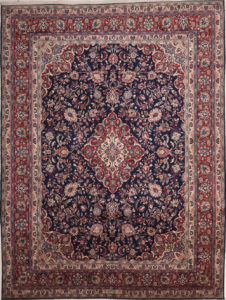
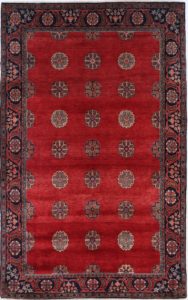
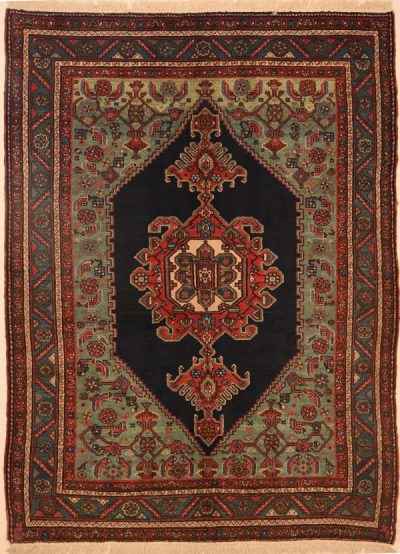
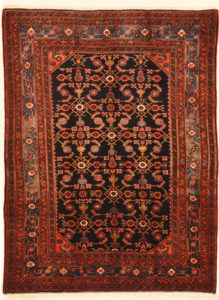
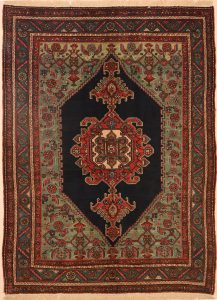
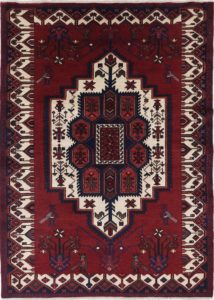
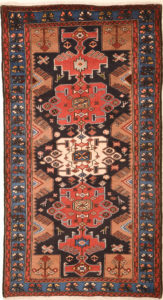
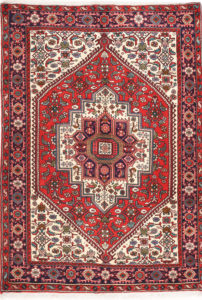
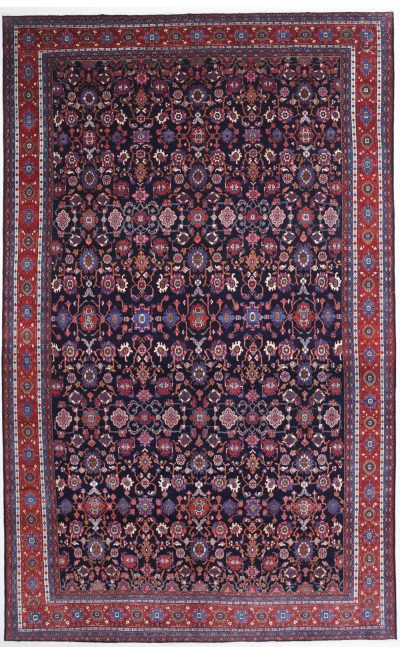
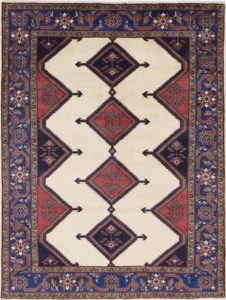
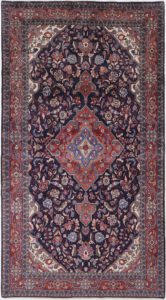
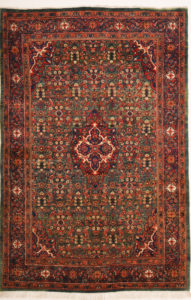
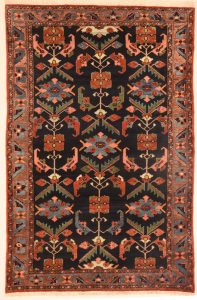
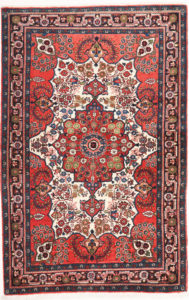
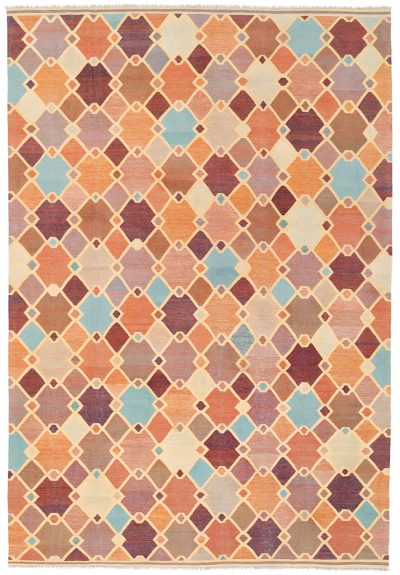
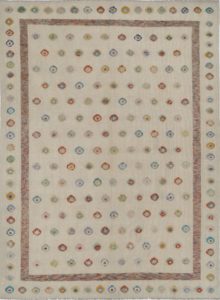
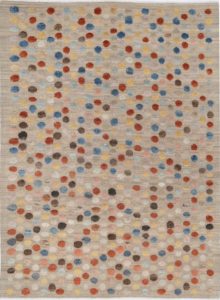
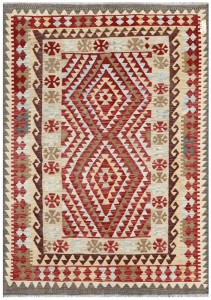
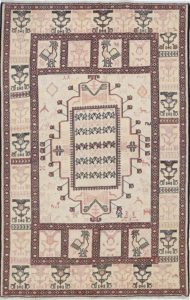
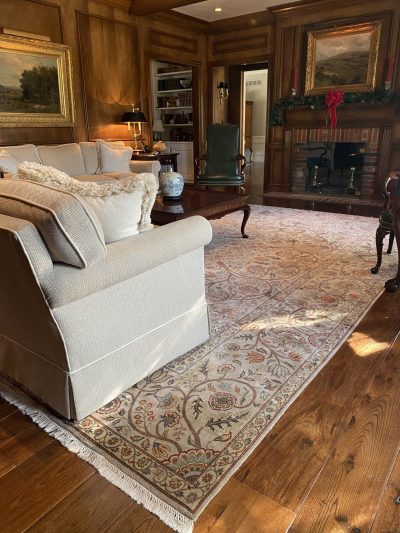
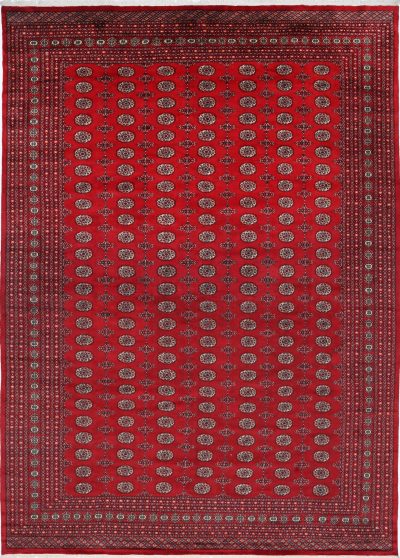
10 thoughts on “Part 2: Types of Persian Rugs”
Thanks
I bought 2 used rugs. Unfortunate they dont have lables. Can you help me to identify it.
Dear Wilma,
Send me pictures if I have information about them I will let you know.
Hi, thanks for providing all these information. i was also wondering if you have any articles about Qazvin rugs which I found out they are very expensive and hard to find. How can I tell if the rug is from Qazvin?
Dear Bita,
Qazvin rugs are hard to find and all of them are antique. you could email me pictures if I have information about your rug I will let you know.
I have 2 Saraband rugs and would appreciate any info you can give me.
send me pictures and I will give you information as much as I know.
Please help me identify this rug. I believe it is “art silk” (artificial silk) Any help appreciated!
MAny thanks!
Rick
cid:[email protected]
cid:[email protected]
I couldn’t see any pictures
This article has been so helpful! I’m seeking a deep red and black rug (no cream). It’s hard to tell if it was a Bakhara or Hariz style.